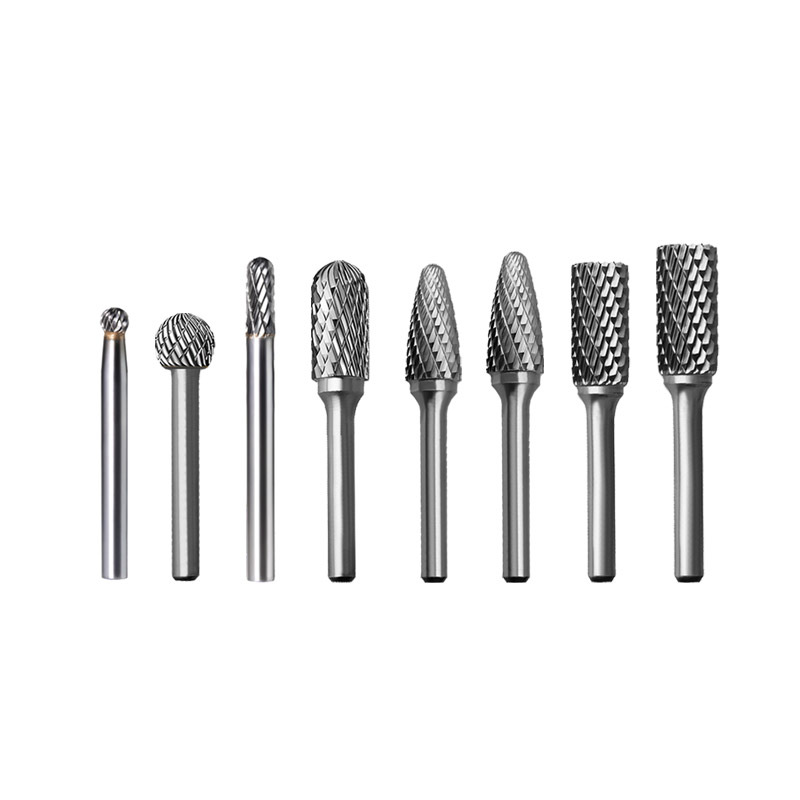Tungsten Carbide Burrs: Technical Insights, Applications, and Advantages
Technical Specifications: Engineering Excellence
- Material Composition
- Tungsten Carbide (WC): Comprises 85–95% tungsten carbide particles bonded with cobalt or nickel. This structure ensures hardness comparable to diamonds and a melting point exceeding 2,800°C .
- Coatings: Titanium nitride (TiN) or diamond coatings further enhance wear resistance and reduce friction.
- Design Features
- Cutting Flutes: Available in single-cut (for fine finishing) and double-cut (for aggressive material removal) designs.
- Shapes: Ball, cylinder, cone, and tree profiles cater to intricate geometries.
- Shank Sizes: Standardized shanks (1/8″ to 1/4″) ensure compatibility with drills, grinders, and CNC machines.
- Performance Metrics
- Speed: Operate efficiently at 10,000–30,000 RPM, depending on material hardness.
- Heat Resistance: Maintain integrity at temperatures up to 600°C, reducing thermal deformation risks .
Applications Across Industries
Tungsten carbide burrs excel in shaping and finishing tasks for both metals and composites:
- Aerospace & Automotive
- Precision Machining: Smoothing turbine blades, engine components, and gearbox parts.
- Deburring: Removing sharp edges from aluminum or titanium alloys to prevent stress fractures .
- Medical & Dental
- Surgical Instruments: Crafting biocompatible implants and orthopedic devices.
- Dental Prosthetics: Refining crowns, bridges, and dentures with micron-level accuracy.
- Metal Fabrication
- Welding Prep: Beveling edges for TIG/MIG welding joints.
- Die & Mold Making: Carving intricate cavities in hardened steel molds .
- Woodworking & Artistry
- Detail Carving: Sculpting fine patterns in hardwood or acrylics.
- Restoration: Repairing antique furniture or musical instruments.
Advantages Over Conventional Tools
- Extended Tool Life
Tungsten carbide burrs outlast high-speed steel (HSS) tools by 10–20x, reducing downtime and replacement costs. Their resistance to abrasion ensures consistent performance in stainless steel, cast iron, and ceramics . - Superior Precision
Sharp cutting edges maintain tight tolerances (±0.01 mm), critical for aerospace components and medical devices. - Versatility
Compatible with metals, plastics, fiberglass, and even bone, these burrs eliminate the need for multiple tool changes. - Heat & Corrosion Resistance
Ideal for high-temperature environments like foundries or chemical processing plants. Cobalt-bonded variants resist oxidation in humid conditions . - Cost Efficiency
Despite higher upfront costs, their longevity and reduced maintenance deliver long-term savings.
Innovations in Carbide Burr Technology
- Nanostructured Carbides: Finer grain structures enhance toughness for brittle materials like carbon fiber.
- Smart Burrs: IoT-enabled tools with embedded sensors monitor wear in real time, optimizing CNC machining workflows.
- Eco-Friendly Designs: Recyclable carbide materials align with sustainable manufacturing goals.
Choosing the Right Carbide Burr
- Material Hardness: Use fine-cut burrs for hardened steel and coarse-cut for soft metals or wood.
- Application Type: Select shapes based on task—e.g., ball burrs for concave surfaces, cone burrs for chamfering.
- Speed Compatibility: Match RPM ratings to your tool’s specifications to avoid overheating.
Conclusion
Tungsten carbide burrs are the unsung heroes of precision engineering, bridging the gap between raw materials and flawless finishes. From crafting jet engine components to restoring vintage violins, their blend of durability, precision, and versatility makes them indispensable. As industries push toward smarter, greener manufacturing, these tools will continue to evolve—delivering efficiency one rotation at a time.
Post time: May-26-2025
